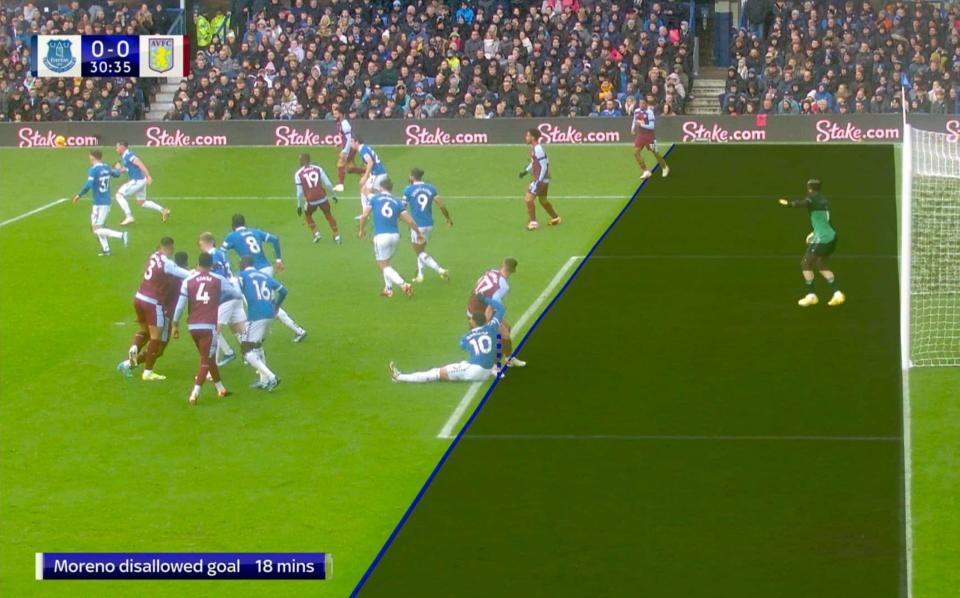VAR is doomed because fans will never truly trust its technology

Now and again, too rarely, you get a sense of your life slipping away in real time. Usually this comes during hour two of a zonked-out doomscroll, realising you have consumed everything new across your preferred social networks with nothing to show for it beyond a jangly, hollowed-out feeling. You can achieve a similar effect with prolonged exposure to the VAR discourse.
Six years of outrage now, since the system was first trialled in the 2017-18 FA Cup. We lurch between re-litigating individual decisions, begging for consistency at times then common sense at others, with occasional existential howls which greet moments like Coventry’s disallowed goal in the FA Cup semi-final. Nottingham Forest broke with protocol and decency last weekend to imply the strings of the Premier League are being pulled by the pernicious influence of Big Luton. We were promised a future without rancour over refereeing decisions, the present has only delivered an extra layer.
Forget about the laws, and ponder the system. It relies on cameras operating at 50 or 60 frames per second which may be inadequate for Premier League passes and players. The Mail on Sunday estimated in 2019 that framerate limitations could mean a margin for error of offsides for the quickest players of 38.8cm. That is not the fabled toenail or armpit, it is a size 20 shoe.
Research by Dr Pooya Soltani of the University of Bath in 2022 found that participants invited to assess VAR-standard footage judged balls were kicked 132 milliseconds later than they had been in reality. “Although seemingly minor, at high speeds, this delay can lead to significant player displacement,” he says. “In faster-paced sports, where athletes move even more swiftly, this displacement is magnified, consequently widening the margin of error.”

You would need high-speed cameras, the sort which can capture events too quick for the human eye to perceive, to eliminate such issues but the cost of both cameras and storage space would be prohibitive. Offside should be an objective truth and seems clear most of the time in person. It becomes murkier when you are zoomed in on a still of fast-moving athletes, the picture has pixellated and the lines placed on the pitch by error-prone human hands appear to be slightly out of position.
Occasionally in areas beyond sport our trust in technology seems to outstrip its competence. Think about the anger when your Pret app stops acting as a frictionless route to flat whites, your smart motorway hard shoulder unexpectedly becomes a live lane or your self-driving car mows down a beloved family pet. The depth of anger about VAR fits this pattern.
From 2021/22 the limitations were acknowledged and a 5cm margin of error was introduced. This effectively creates a ‘benefit of the doubt’ zone, where if the two lines we see drawn on the pitch during VAR offside investigations are touching, the line turns green and it is deemed onside. That green line will disappear next season when we welcome semi-automated offside.
This will use skeletal-tracking systems which follow around 30 joints on every player’s body. The system will deliver graphical representations of decisions and increased certainty about the exact points of contact with the ball. But we can also look forward to renewed gripes about tiny indiscretions which, seemingly, an algorithm has ruled on. Buy stock now in Little Britain “computer says no” GIFs.
Even then, the system may not be faultless. “Some peer-reviewed validation studies generally report favourable results, but suspicions linger due to clear discrepancies between video sequences and bone overlays, especially when played frame by frame,” says Dr Soltani.
“AI is also trying to precisely locate the skeleton, crucial for creating crisp animations. Yet, if imaginary bone lengths are even slightly inaccurate, animations can go awry, with hands intersecting or ankles bending as if they are broken. Despite the portrayal of accuracy, AI comprehends visual appearance, not functional mechanics. It cannot discern, for instance, if an ankle cannot be reversed, it merely guesses where ankle-like pixels should be.”

Theoretically the new system will move us closer to 100 per cent accuracy but is that really what supporters want? Anecdotally there are plenty of fans, journalists, and even managers who now prefer to consume their football away from the top flight and the emotion-sapping additional layer of VAR.
Semi-automated offside sounds like another supposed improvement which will only inflame the debate further. Letter of the law absolutists vs faux-zen traditionalists. One side shouting “but it IS offside” the other claiming unconvincingly they would accept bad decisions against their clubs and no VAR. Forever. If that sounds bad, consider the very worst outcome imaginable.
Taken to theoretical extremes, what if a demonstrable fault was discovered with the tech used to make VAR decisions? Years of paranoid conspiracies are vindicated, decades of lawsuits follow and the entire integrity of the competition is in tatters. We could be looking at a semi-automated Horizon scandal.
The PR battle has been lost but perhaps there is still a solution which preserves the benefits of VAR? I am yet to hear a compelling argument against the method which works in cricket, NFL and tennis: give managers a finite number of appeals to use at their discretion. If wrong, you lose the appeal, if right you do not.
Yet this solution falls into the fatal cognitive trap about VAR, that it would be unanimously popular if we just come up with the right tweaks. We have had plenty of evidence now to prove that the only true fix would be travelling back in time and deciding that sensors on the goal line are quite enough technology for football.

